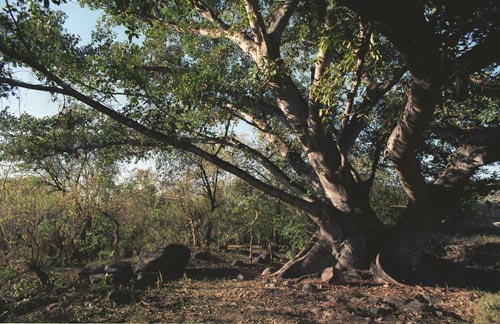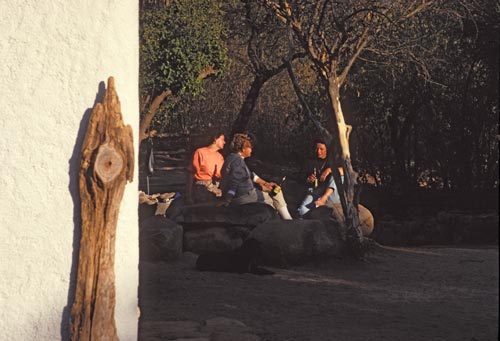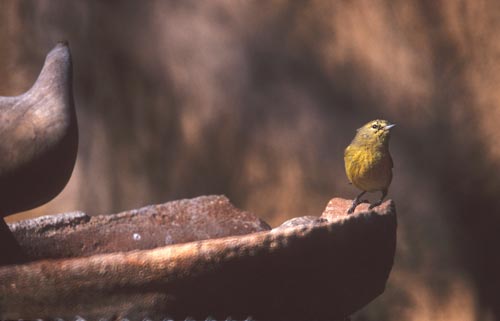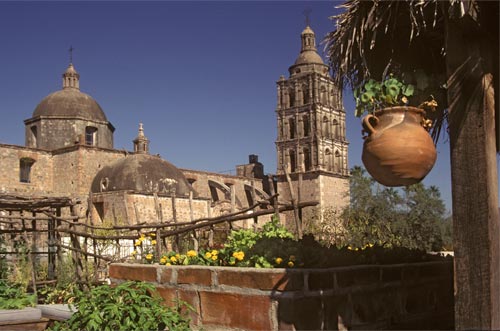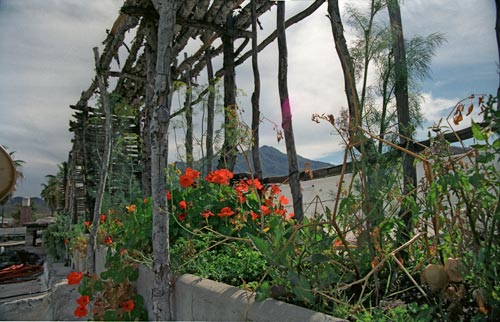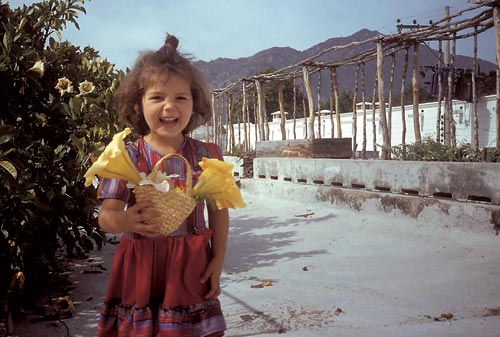Elizabeth Nuzum was the first person I met after waking up in Calle Comercio 2 after a 900 mile car-with her son Kit Nuzum and his girl friend. Elizabeth was in the kitchen along with her helper Alba. I introduced myself, Anders Tomlinson, and she asked what my full name was. I replied Anders Paul Tomlinson. She looked into my eyes and said that would be a wonderful name for a writer. I was one of many, more likely a multitude, that were greeted, and complimented, by Elizabeth on their arrival to Alamos, Sonora, Mexico.
Elizabeth passed away June 18, 2014 at the age of 93 in Tuczon, Arizona. Her life began in Manila, the Philippines. Her early years were spent in China and Japan. She met, and married, Pember Nuzum while attending Scripps College in Claremont, CA. It was a life of big pictures, details, friends, helpers and those she helped. She was a flower that opened up, blooming every day, to the world.
Pember and Elizabeth were part of the fabric that is Álamos, Sonora, Mexico. At times, they had a hand in selecting materials and tailoring of this social fabric. They were colorful, as big as life and up to the countless challenges that comes with building a home in another land rich with history, tradition and culture.
I appreciate Pember and Elizabeth’s kindness which helped me develop the project that is reflected by the website you are currently visiting. Here are a couple of articles that featured Elizabeth.
99… Elizabeth’s experimental place – garden, El Pedregal… first of two parts…
Pember and Elizabeth Nuzum owned a lot off a dirt road in the Chaleton area, place of the fig trees, west of Alamos. They planned to built a tennis court on it. One day Elizabeth traveled further west on the road and came across this fig tree. It was love at first site. She coaxed Pember into selling their lot, and it sold unexpectedly quickly. Elizabeth, on her own, purchased the undeveloped three acres with the fig tree from Martha and Al Haywood. Elizabeth christen the property El Pedregal, the stoney place. This was her project, her experimental place to build and plant what she wanted. It was her dream to bring art, community and nature together under the out-stretched limbs of a magnificent fig tree.
The first thing Elizabeth did at El Pedregal was build a meandering road leading through and around the property to the fig tree. The heavy green gates at Pedregal’s entrance, where the public dirt road comes to its end, were made from old doors Elizabeth collected in town. She had put them together by Nemecio Figueroa in his family’s carpenter shop on the way to the Panteon, cemetery, at the eastern edge of town. Behind these green gates there were, and are, worlds of natural wonder. The seasons pass as birds, insects and mammals come and go.
A straw-bale studio…
Elizabeth had read the book Out on a Limb by Peter and Victoria Nelson. It was about tree houses and other construction such as straw-bale houses. Elizabeth decided she wanted to build a straw-bale in her garden of experiments. She contacted the Nelsons as they were preparing to visit Russia and demonstrate straw-bale technology. They recommended that she talk to the authors of The Straw-Bale House, Bill and Athena Steen. Elizabeth felt it was important to build a straw-bale structure as an example of what could be a relatively inexpensive home concept for Mexico. Unable to have an expert come down to build the straw-bale studio she relied on the Steen’s book and hired her son-in-law Chacho Valdez and his brothers to start the project. Chacho would build the basic structure: roof, walls and an unfinished floor.
A palapa for all seasons and reasons…
Before the Straw-bale studio was started Elizabeth and Chacho took a stick and scribed out a large circle as the palapa’s floor-plan. Her intent was to have a place where people could socialize and admire the fig tree. She wanted it to have two entrances and no center pole. Chacho said it could be done and he went about construction.
The amazing hand-woven palapa roof took a crew five months to put together as they had to wait for after full moons to collect the palapa leaves. As work continued on the property the fig tree was host to shamanic dances, earth renewal ceremonies, sweat lodges, barbecues, coffee parties, art classes and…
Chacho Valdez, man of mystery…
I always thought of Chacho as a rock n’ roll medicine man. He looked like a pirate with long flowing hair and beard, bandanas and hats. One day Chaco looked at me with one eye somewhere else and stated, ”if you stare at a cloud long enough it will disappear…” This is an anthem-theme that I use whenever I speak of Alamos.
Chacho and Cammie, his former wife, were instrumental in creating the Children’s Kite Festival held in the spring. Chacho, a bit of a mischievous child himself, loved children. He also loved to sing in his big booming voice. The last time I saw Chacho he was building a circular two-story house on the well-traveled entrance road up to the top of El Mirador. The site doesn’t seem like it would be conducive for privacy during park visiting hours but, my oh my, what a magnificent awe-inspiring view! …
98… Returning to El Pedregal’s ever-present spirit… second of two parts…
Liliana Carosso, on the right, and Ginny Brown, along with an unidentified woman in the middle, enjoy a natural moment. Lilliana is a prominent Alamos real estate agent. Here, one is in another world. Time loses importance and nature, and a couple of beers, encourages relaxed deep breathing.
Kit Nuzum returns to Alamos…
Elizabeth’s son, Kit, returned from one of his many global travels and took over the task of finishing the straw-bale studio. He also managed the digging of a well at the spot chosen by a water dowser. A solar pump was installed and irrigation began with water from beneath El Pedregal”s surface. Elizabeth purchased indigenous and rare trees and plants. And as the nature is for these parts some took, and some didn’t as any Alamos gardner has experienced.
Kit had no prior working knowledge of straw-bale construction and “just went for it” with the help of Chone, a cousin of Chacho. They poured an earthen adobe floor with the help of Steve Frielobs. The windows were made by Angel Rosas. The adobe interior walls that made the kitchen and bathroom was there but unfinished. Kit and Chone, along with several others, finished the walls and the loft decking as well as the grand stair case, designed by Alamos resident Irmine Stelzner, with wood from the old Boors monastery on the southwest corner of the Plaza. The original douglas fir came by train from Oregon in 1910. Irmine’s husband Allen Stelzner designed and made the iron latch on the front door.
Creating color pigment from nearby hills…
Elizabeth’s straw-bale studio was originally painted with a palette of colors made from dirt in the surrounding hills. The soil that would be used to make the paint came from a spot that was along a long walk that Chacho took me on the last day of my first visit to Alamos. Chacho said it was a local custom. As we were returning to Alamos I asked Chacho if the earth was purple and he nodded yes. In this one area there was literally a rainbow of dirt. Fifteen years later, Kit and I, along with a couple of assistants and a wheel barrow, set off to find this magical place. We found it not far from El Pedregal along with shards of am old pottery. The work crew spent the morning gathering earthen colors from the area as I filmed. Later, Kit mixed the earth-toned dirts – pale green, red, blue, green, ivory, white and lavender with prickly pear and agave goo called baba. The solution sat for a week before glue was added and wiped onto the interior walls: home made paint.
Later, author Paul Molyneaux, seeking a quiet harbor from his noisy young children, finished his book The Doryman’s Reflection, a Fisherman’s Life in the serene straw-bale studio. Tony Estrada, director of the Museo de Costumbrista and artist, sculpted a centaur for Elizabeth that was placed beneath the fig tree.
On this summer day in 1996 I would go on a hike with Chacho, his young son Sereno, his girlfriend and Chone to the top of Tecolete Hill, seen here sun-capped. Sierra de Alamos rises up in the background. We would leave from El Pedregal at sunrise and be atop Tecolote Hill in a couple of hours. This turn out to be a day of exercise and aroma therapy in Alamos, Sonora, Mexico.
El Pedregal today…
Elizabeth sold El Pedregal to Jennifer and David MacKay in 2005. They added another 17 acres to what is now El Pedregal Nature Lodge and Retreat Center. They have also upgraded the infrastructure and added a couple of casitas. Today, they offer lodging, nature tours, sunday brunches and yoga lessons amongst many other activities that they are involved with.
I recently enjoyed watching David Wilson’s Big Birding Day on PBS’ POV, point-of- view, series. The 2011 12-minute film features David Mckay as a birding guide for several birders intent on a big birding day. The film documents the world of competitive bird watching where one tries to see, or hear, as many bird species as one can in 24 hours. The opening scene takes place under the Pedregal’s palapa as they prepared for a day of ambitious adventure. I was struck by David’s curiosity and connection to his environment.
I had spent nine years filming wildlife on the Tulelake, Lower Klamath, Clear Lake, Upper Klamath Lake and Klamath Marsh National Wildlife Refuges along the California-Oregon border. If David had come and spent a couple of days in the field with me he would have had a wonderful time. And I am equally sure I would enjoy spending a couple of days with David Mckay in Alamos and surrounding habitats. Both of these regions are known for diversity of flora and fauna, especially numbers of bird species. There are birds that visit both Alamos and Tulelake on their yearly migrations.
Elizabeth Nuzum placed this bird bath on Pedregal’s giving ground for her small friends to use, just as she built the straw-bale studio and palapa for friends to visit with friends, even if it is only communing with one’s self, alone.
This entry was aided by notes from Elizabeth Nuzum, Kit Nuzum and Joan Winderman.
78… A rooftop that lives and breath all things Alamos…
Here, in the shadow of cathedral bells and angelic choirs was a multi-purpose rooftop garden. A narrow wrought iron caracol, snail, spiral staircase led one up from a back patio with a small pool to an expansive array of raised planter boxes. Elizabeth Nuzum enjoyed people, her home, her gardens and life in Alamos. For many, her husband Pember and Elizabeth were Alamos greeters, welcoming visitors inside the old wood doors on Calle Comercio. Elizabeth designed and managed her gardens while Pember kept an eye on the household finances.
The roof top garden and its 360 degree views was a special place. The sky at night, with stars there to be touched while one laid back on a substantial Sonoran cot, was a connection to all things in all places. Rooftop eavesdropping on the comings and goings along Calle Comercio and Calle Guadaloupe Victoria tuned one in with the heartbeats of Alamos: Bishop Reyes Cathedral, Palacio, Plaza de Las Armas, Mercado, all points of the compass and all events past and present.
Let me count the sounds I heard up on the roof: uniformed school kids walking in groups, talking, laughing, singing, stepping off rhythms, kicking balls, kids being all things kids. Occasional horse hoofs echoing on cobblestone streets. Music from rattling car and truck radios ricocheting off narrow streets. Surround sound bird songs and calls punctuated by barking dogs, working hammer and saws and distant braying burros. All combinations of people passing by: one, two, or three generations together talking, workers, errand runners, neighbors en-route to visit neighbors or hang out in the Plaza, shop at the Alameda and Mercado or attend to business at the Palacio or… This garden overlooked the center of Centro Alamos’ rainbow of expression: joy, surprise, acceptance, expectations, anger, yearning, anticipation. greetings, farewells…
Christina Vega, daughter of Chacho and Cammie, sister of Gaspar, walked in all worlds Alamos. Her Mexican blood was Chaco’s large family and her American blood was Cammie’s parents Elizabeth and Pember and brother Kit who came to visit from his world travels. Cammie and Chacho lived modestly on Calle Ninos Heroes, a short walk from the grand roof top garden on the the other side of Guadaloupe Hill.
The roof’s northwest corner, with a view into the Plaza and Gazebo, was across the street from the bank. At opening time a line of people would be waiting sharing conversation. Daily masses brought people to the church’s eastern door. Funerals processions would leave the church and passed by as they headed east to the Panteon – Cemetery. Police headquarters, at times busy, were three houses to the east on Calle Comercio. Tourists speaking English, French, German and other languages would stop and chat as they headed to and from surrounding lodging. At night, one could listen to quitar playing coming from Polos restaurant’s kitchen as well as the Estudiantina practicing at the Museum. At this moment Christina is listening to the public serenade that is Alamos.
Pember told Anders, “always call us Alamos, Sonora, Mexico.” And Anders has.
Pember and Elizabeth Nuzum were a major part of the North American Community for decades. Their casa next to the Church on Calle Comercio #2 greeted many many who visited Alamos, including Anders. It is not uncommon to have rain squalls in December. And it was common to hear Pember playing his theater organ in the Nuzum music room. Those days are gone. But the spirit lingers, it always does.
A film crew embraced by the Nuzums’ hospitality
From left to right: Chaco Valdez, painting of Christina Vega by Jim Wison, Anders Tomlinson,
Gary Ruble, Donna Beckett, R. L. Harrington, Robert Ganey, and the Nuzums: Jolene, Kit,
Elizabeth and Pember. At this moment we were all together and thankful. This is an example
of the Nuzums reaching out to others and their love for Álamos, Sonora, Mexico.
To see Elizabeth and Pember’s Alamos home visit Calle Comercio 2
To see more Alamos Journal pages.
To return Home.




